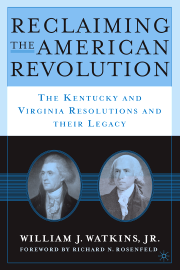June 2015 marks the 800th anniversary of Magna Carta. Part peace treaty and part written constitution, the Great Charter is the fountainhead from which so many cherished American liberties spring.
King John ruled England from 1199 to 1216. During this period, he caused pain and hardship for all his subjects. John’s early quarrels with Pope Innocent resulted in the issuance of an interdict that suspended church services and the administration of various sacraments. Those who died during this time, to the heartbreak of their families, were denied a Christian burial.
John engaged in a series of wars in France to recover family lands. These foreign wars wearied the nobles with the constant calls for military service and money to fund John’s unsuccessful military campaigns.
John seized church and private lands when the opportunity arose. Throughout his reign, he pursued policies that caused subjects to fall into debt to him so that he could control them and extort various favors. British historian Rebecca Frasier rightly describes John as “a tyrannical, greedy, and lawless ruler.”
In 1215, the great barons rebelled against the king. Unlike previous rebellions where the rebels rallied around an alternative royal dynasty, the barons focused on a broad program of government reform. After they captured London, John realized that he would have to acquiesce to the terms they demanded. The result was Magna Carta.
The Great Charter contained 63 provisions that dealt with diverse matters such as inheritance, taxation, and the administration of justice. For example, the 12th clause prohibits the levying of certain taxes “without the common counsel of the kingdom.” Clause 20 prohibited excessive fines and punishment and Clause 40 forbade royal officials from selling justice.
The 39th clause forms the basis of the Due Process Clause found in the Fifth Amendment to the United States Constitution: “No freeman shall be taken or imprisoned or disseised or exiled or in any way destroyed ... except by the lawful judgment of his peers or the law of the land.”
The Great Charter recognized that power can only be checked by power. It created a committee of 25 barons who were to monitor the actions of the king and his officials. If the crown took action contrary to the guarantees of Magna Carta, four barons could petition for relief. If the grievance was not addressed, then the committee of 25 “together with the commune of the whole land, shall distrain and distress us in all possible ways, as by seizing our castle, lands, possessions, and any other way open to them.”
As a peace treaty, Magna Carta was a failure. John never intended to abide by the terms of the documents and within weeks of his accepting it, hostilities began anew. But as a charter of liberties—a beacon to which the oppressed could turn—Magna Carta endured.
In the 20th century it became fashionable to dismiss the document as one by the nobles, for the nobles, and of the nobles. In truth, Magna Carta contained something for everyone and was appealed to by great and small when threatened by an overreaching king or government.











